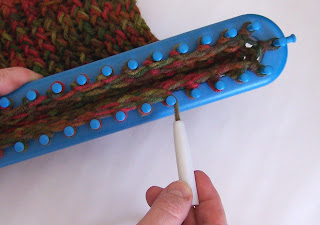Felting -- Folly or Fun?

In the washer, I checked it every few minutes, and the felting seemed to be going pretty slowly. The columns of stitches (e-wraps) were felting, but there were gaps in between the columns (traveling yarn, also called bars), so I just let it stay in for the whole cycle. I was going to throw it into the dryer if necessary -- my wool sweaters have felted wonderfully in the dryer, especially when I didn't mean to put them in there -- but the bag looked pretty good at the end of the wash cycle. The columnar texture was still there, rather like large wale corduroy, and I didn't want the bag to get any smaller.
I put a plastic bag in it and stuffed it with newspapers, but it was kind of lumpy and I didn't want my bag to look shapeless.

Then I spied a Cream of Wheat box that looked to be just the right size, and figured I'd get a cleaner shape to my bag if it dried around the box. I was also able to shape the bag so the columns would be perpendicular, not twisted or biased.

The tab was off center, and I decided this bag would be perfect for carrying a couple water bottles. I drink a lot of green tea, and don't mind if it's at room temperature, so this will be designated as my "tea bag." The button tab wasn't long enough to reach over the bottles, so I cut it off. You can barely tell where the tab was; the top edge is rounded but the cut edge was flat. I wet that spot and massaged it with my fingers for a few minutes to soften the cut area. Then I knit and felted a long strap to sew on to the two short sides of the bag. The felting of the strap took two complete wash cycles. From what I've read, smaller pieces take longer to felt than larger pieces. Still, no purchased handles or button needed after all!


Just to spruce it up a bit, I added a blanket stitch around the edges.

A few things I learned:
I still want a button-tab bag with short handles, so I'll be knitting up another. Stay tuned!







